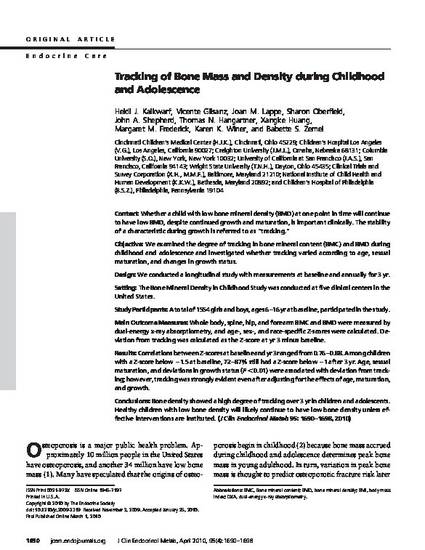
Context: Whether a child with low bone mineral density (BMD) at one point in time will continue to have low BMD, despite continued growth and maturation, is important clinically. The stability of a characteristic during growth is referred to as “tracking.”
Objective: We examined the degree of tracking in bone mineral content (BMC) and BMD during childhood and adolescence and investigated whether tracking varied according to age, sexual maturation, and changes in growth status.
Design: We conducted a longitudinal study with measurements at baseline and annually for 3 yr.
Setting: The Bone Mineral Density in Childhood Study was conducted at five clinical centers in the United States.
Study Participants: A total of 1554 girls and boys, ages 6–16 yr at baseline, participated in the study.
Main Outcome Measures: Whole body, spine, hip, and forearm BMC and BMD were measured by dual-energy x-ray absorptiometry, and age-, sex-, and race-specific Z-scores were calculated. Deviation from tracking was calculated as the Z-score at yr 3 minus baseline.
Results: Correlations between Z-scores at baseline and yr 3 ranged from 0.76–0.88. Among children with a Z-score below −1.5 at baseline, 72–87% still had a Z-score below −1 after 3 yr. Age, sexual maturation, and deviations in growth status (P < 0.01) were associated with deviation from tracking; however, tracking was strongly evident even after adjusting for the effects of age, maturation, and growth.
Conclusions: Bone density showed a high degree of tracking over 3 yr in children and adolescents. Healthy children with low bone density will likely continue to have low bone density unless effective interventions are instituted. (J Clin Endocrinol Metab 95: 1690–1698, 2010)
Available at: http://works.bepress.com/thomas_hangartner/54/

Copyright © 2010 by The Endocrine Society.
Authors may deposit the final PDF version of their manuscript in their institutional repository or other archive 1 year following the date of print publication. Any deposits to be made prior to 1 year following the date of print publication must be approved by the Publications Department of The Endocrine Society.